Study on the Flow, Foaming Characteristics and Structural Strength of Polypropylene Structural Foam Injection Molding by Innovative Nitrogen and Molten Plastic Mixing Mechanism
Abstract
:1. Introduction
2. Model, Materials, and Methods
2.1. Molding Mechanism
2.1.1. Injection Molding Machine
2.1.2. Nitrogen Device
2.1.3. Preparing the Specimens
2.2. Molding and Foaming Materials
2.3. Characterizations
- For the analysis and experimentation of melt rheology, 30 specimens were tested under the same molding parameters. The last 20 test molded samples’ average value was used for melt flow pressure measurement, calculation of the melt-viscosity index, and observation of foaming shape.
- Carried out with different gas contents (“wt%” is the percentage by weight (%); wt (weight)), and according to the change of its content, the melt pressure/viscosity index, and foaming characteristics, the appropriate comparative trends were explored and the parameter changes carried out in the second stage.
- In the second stage, the changes in the effect of cell density on the structural strength of PP were evaluated by varying several parameter settings of the process (screw speed, melt temperature, injection speed, etc.; Table 2).
2.3.1. Measurement of Melt Flow Pressure
2.3.2. Scan and Analysis for Inside the Foamed Parts
2.3.3. Flexural Strength Test
3. Results
3.1. Effects of Nitrogen-Fill Content Variation and Melt Fluidity Properties
3.1.1. Melting Pressure and Its Relevance to Viscosity Index
3.1.2. Melt Fluidity and Its Effect on Foaming Characteristics
- As the melt passes the first bend in the test piece, the pushing pressure is easily inhibited by the impact of the bend. Therefore, the pressure after the first bend is unable to transmit, and the foaming structure and its size after the first bend will naturally become increasingly large. At the same time, due to the heat transfer of the mold runner, the melt on the superficial level will cure during the flowing stage in the melt-filling stage. Therefore, the thickness of the superficial level after Position 2 will gradually become more visible. In contrast, when gas content increases, it also means the gas generation ratio and density inside the melt are increased. Thus, although Position 1 is close to the gate, as the content is increased, the area of the foam will also gradually increase.
- Since the gas content is increased, the foaming structure and its density obtained will also gradually increase, followed by the flow path and decreasing pressure trend of the melt. Additionally, the pressure inside the melt equals the changes that affect the growth of foaming structure and density, and under the trend along the melt flow path in response to the changes of the pressure decrease, the ratio of foam growth has increased, whereas the melt undergoes the filling stage and is cooled/cured by the mold runner, and the ratio of the superficial level of the end product becomes increasingly clear. At the same time, as the gas content increases, the internal pressure of the foam growth is greater than the internal pressure of the melt, the foam structure increases, and the area of the superficial level reduces.
3.2. DOE and Its Correlation Analysis of Quality Characteristics
3.2.1. Screw Speed Variations
- Due to the stretching flow of the flow path change, the melt pressure under pressure will cause the melt-viscosity index to increase. To cooperate with the screw at low speed and the changes of low/high gas content, the plasticizing time is longer due to low rotation speed, which increases the compatibility between the gas and the melt during the plasticization stage. Therefore, under the setting of low rotation speed and increased gas content, the pressure, flow resistance, and melt-viscosity index during the filling process is relatively lower.
- Furthermore, within the changing screw speed, when the rotation speed increases, the refining effects of the gas increase as the gas is released into the melt through the permeable steel, making it easier to fuse into the melt. Therefore, it can be seen from the cell density trend that the melt-viscosity index and the cell density in the changing screw speed are negatively related.
- By comparing the strengths of the bending test, the cell density equals reducing the material density of the melt. Thus, the higher the cell density, the more the foaming structure and the bending resistance are reduced. So, with the increased screw speed and gas content, the bending strength resistance also decreases.
3.2.2. Melt Temperature Variations
- Under low material temperature and increased gas content settings, the pressure, flow resistance, and melt-viscosity index during the filling stage were relatively lower. In contrast, the lower melt temperature affected the gas in the output and plasticization process, making it difficult to become compatible with the melt, thus yielding a lowered cell density.
- At the same time, in response to the lower melt temperature, the cooling/curing efficacy of the mold runner increased, leading to a higher ratio in the melt curing area than foam growth. Conversely, with the higher melt temperature, a longer cooling time in the mold runner was required for curing, during which the foam continued to grow within the high-temperature melt in the core level, thus increasing the cell density. It can be seen that the melt-viscosity index and the cell density in the changing melt temperature are positively related.
- By comparing the strengths of the bending test, the cell density equals reducing the material density of the melt. Thus, the higher the cell density, the more the foaming structure and the bending resistance are reduced. Therefore, with the increased melt temperature and gas content, the bending strength resistance also decreases.
3.2.3. Injection Speed Variations
- The melt inside the mold produced high shear force due to the cooling/curing effect of the mold runner, which increased the viscosity of the melt. However, when using the faster injection speed, the curing efficacy of the mold runner was unable to keep up with the propulsion speed to push the melt into the mold cavity, so the pressure, flow resistance, and viscosity factor during the filling stage were relatively lower.
- In contrast, since the slower injection speed caused a greater melt viscosity factor inside the mold, this means that there was greater pressure within the melt, which affected the growth ratio of the foam. Thus, when representing the cell density, it was found that the trend for the cell density between the injection speed of 40 and 70 mm/s range was not visible. Conversely, the faster injection speed increased the time the melt remained inside the mold, and the pressure within the melt was lower, thus increasing foam growth and cell density. It can be found from the trend that the viscosity factor and the cell density in the changing injection speed are positively related.
- By comparing the strengths of the bending test, the cell density equals reducing the material density of the melt. Thus, the higher the cell density, the more the foaming structure and the bending resistance are reduced. Therefore, with the increased injection speed and gas content, the bending strength resistance also decreases.
4. Conclusions
- i.
- Through the installation of the real-time sensor system for the pressure at the gate, the pressure history of the plasticization/injection/foaming process and the changing trend of the melt-viscosity index could be successfully determined. Additionally, in the pressure trend of the gas–melt mixture, the amount of the gas content could be confirmed, which is an important factor that indirectly affects the flow feature of the melt filling.
- ii.
- The trend between the melt pressure and the obtained melt-viscosity index was calculated to be positively related. Additionally, in the trend for different gas contents, the gas content could affect the fluidity of the material when within a set range. However, if the content exceeded the range, the pressure trend was unavailable.
- iii.
- During the process of foam molding, the melt-viscosity index and the foaming structure and its density were positively related; through the input of gas and an increase in its content during the plasticization stage, it increased the lubricity/fluidity within the melt. The obtained melt was more easily pushed and did not require the screw to provide excessive pressure to push the melt into the mold cavities. The foaming structure also changed.
- iv.
- The higher the cell density, the more the bending resistance decreased, which also reduced the bending strength because of the interaction between the cell density, the thickness of the skin layer, and the foaming structure, leading to changes in its strength.
Author Contributions
Funding
Institutional Review Board Statement
Informed Consent Statement
Data Availability Statement
Conflicts of Interest
References
- Zhang, A.; Wang, J.; Wang, G.; Jiang, L.; Meng, X.; Zhao, G. Microcellular injection molded lightweight, strong and thermally insulating PP/fibrillated-PTFE composite foams with enhanced surface appearance. J. Mater. Res. Technol. 2023, 22, 2933–2943. [Google Scholar] [CrossRef]
- Bao, J.-B.; Nyantaki, A., Jr.; Weng, G.-S.; Wang, J.; Fang, Y.-W.; Hu, G.-H. Tensile and impact properties of microcellular isotactic polypropylene (PP) foams obtained by supercritical carbon dioxide. J. Supercrit. Fluids 2016, 111, 63–73. [Google Scholar] [CrossRef]
- Mendoza-Cedeno, S.; Kweon, M.S.; Newby, S.; Shivokhin, M.; Pehlert, G.; Lee, P.C. Improved Cell Morphology and Surface Roughness in High-Temperature Foam Injection Molding Using a Long-Chain Branched Polypropylene. J. Polym. 2021, 13, 2404. [Google Scholar] [CrossRef]
- Suh, K.W.; Park, C.P.; Maurer, M.J.; Tusim, M.H.; De Genova, R.; Broos, R.; Sophiea, D.P. Lightweight cellular plastics. Adv. Mater. 2000, 12, 1779–1789. [Google Scholar]
- Hasanzadeh, R.; Azdast, T.; Lee, P.C.; Park, C.B. A review of the state-of-the-art on thermal insulation performance of polymeric foams. Therm. Sci. Eng. Prog. 2023, 41, 101808. [Google Scholar] [CrossRef]
- Park, C.B.; Cheung, L.K. A study of nell nucleation in the extrusion of polypropylene foams. Polym. Eng. Sci. 1997, 37, 1–10. [Google Scholar] [CrossRef]
- Leaversuch, R.D. Enhanced PP resins offer a wide balance of properties. Mod. Plast. 1996, 26, 46–49. [Google Scholar]
- Pang, Y.; Cao, Y.; Zheng, W.; Park, C.B. A comprehensive review of cell structure variation and general rules for polymer microcellular foams. Chem. Eng. J. 2022, 430, 132662. [Google Scholar] [CrossRef]
- Yu, K.; Ni, J.; Zhou, H.; Wang, X.; Mi, J. Effects of in-situ crystallization on poly (lactic acid) microcellular foaming: Density functional theory and experiment. Polymer 2020, 200, 122539. [Google Scholar] [CrossRef]
- Wang, Z.; Zhao, J.; Wang, G.; Xu, Z.; Zhang, A.; Dong, G.; Zhao, G. Lightweight, low-shrinkage and high elastic poly(butylene adipate-co-terephthalate) foams achieved by microcellular foaming using N2 & CO2 as co-blowing agents. J. CO2 Util. 2022, 64, 102149. [Google Scholar] [CrossRef]
- Rizvi, A.; Tabatabaei, A.; Vahedi, P.; Mahmood, S.H.; Park, C.B. Non-crosslinked thermoplastic reticulated polymer foams from crystallization-induced structural heterogeneities. Polymer 2018, 135, 185–192. [Google Scholar] [CrossRef]
- Wang, L.; Lee, R.E.; Wang, G.; Chu, R.K.; Zhao, J.; Park, C.B. Use of stereocomplex crystallites for fully-biobased microcellular low-density poly(lactic acid) foams for green packaging. Chem. Eng. J. 2017, 327, 1151–1162. [Google Scholar] [CrossRef]
- Zhou, D.; Xiong, Y.; Yuan, H.; Luo, G.; Zhang, J.; Shen, Q.; Zhang, L. Synthesis and compressive behaviors of PMMA microporous foam with multi-layer cell structure. Compos. Part B Eng. 2018, 165, 272–278. [Google Scholar] [CrossRef]
- Zhang, H.; Zhang, G.; Gao, Q.; Zong, M.; Wang, M.; Qin, J. Electrically electromagnetic interference shielding microcellular composite foams with 3D hierarchical graphene-carbon nanotube hybrids. Compos. Part A Appl. Sci. Manuf. 2020, 130, 105773. [Google Scholar] [CrossRef]
- Wang, L.; Ishihara, S.; Ando, M.; Minato, A.; Hikima, Y.; Ohshima, M. Fabrication of high expansion microcellular injection-molded polypropylene foams by adding long-chain branches. Ind. Eng. Chem. Res. 2016, 55, 11970–11982. [Google Scholar] [CrossRef]
- Naguib, H.E.; Park, C.B.; Reichelt, N. Fundamental foaming mechanisms governing the volume expansion of extruded polypropylene foams. J. Appl. Polym. Sci. 2004, 91, 2661–2668. [Google Scholar] [CrossRef]
- Romero-Diez, S.; Kweon, M.S.; Kim, E.S.; Gupta, A.; Yan, X.; Pehlert, G.; Park, C.B.; Lee, P.C. In situ visualization of crystal nucleation and growth behaviors of linear and long chain branched polypropylene under shear and CO2 pressure. Polymer 2021, 213, 123215. [Google Scholar] [CrossRef]
- Liao, R.; Yu, W.; Zhou, C. Rheological control in foaming polymeric materials: II. Semi-crystalline polymers. Polymer 2010, 51, 6334–6345. [Google Scholar] [CrossRef]
- Kim, E.; Kweon, M.S.; Romero-Diez, S.; Gupta, A.; Yan, X.; Spofford, C.; Pehlert, G.; Lee, P.C. Effects of pressure drop rate and CO2 content on the foaming behavior of newly developed high-melt-strength polypropylene in continuous extrusion. J. Cell. Plast. 2020, 57, 413–432. [Google Scholar] [CrossRef]
- Schiffers, R.; Kruppa, S.; Moser, S. The right changeover point for each shot. J. Kunststoffe 2014, 11, 26–29. [Google Scholar]
- Kruppa, S.; Holzinger, G.P. In Situ Characterization of Polymer Melt and Molded Part Quality; KraussMaffei Technologies GmbH: Munich, Germany, 2013. [Google Scholar]
- Bridges, S.; Robinson, L. A Practical Handbook for Drilling Fluids Processing. In Gulf Drilling Guides; Gulf Professional Publishing: Oxford, UK, 2020. [Google Scholar]
- Tsai, M.-H.; Fan-Jiang, J.-C.; Liou, G.-Y.; Cheng, F.-J.; Hwang, S.-J.; Peng, H.-S.; Chu, H.-Y. Development of an Online Quality Control System for Injection Molding Process. Polymers 2022, 14, 1607. [Google Scholar] [CrossRef]
- Su, C.-W.; Su, W.-J.; Cheng, F.-J.; Liou, G.-Y.; Hwang, S.-J.; Peng, H.-S.; Chu, H.-Y. Optimization process parameters and adaptive quality monitoring injection molding process for materials with different viscosity. Polym. Test. 2022, 109, 107526. [Google Scholar] [CrossRef]
- Chen, Y.-S.; Wu, K.-T.; Tsai, M.-H.; Hwang, S.-J.; Lee, H.-H.; Peng, H.-S.; Chu, H.-Y. Adaptive process control of the changeover point for injection molding process. J. Low Freq. Noise Vib. Act. Control 2019, 40, 383–394. [Google Scholar] [CrossRef]
- Leung, S.N.; Wong, A.; Guo, Q.; Park, C.B.; Zong, J.H. Change in the critical nucleation radius and its impact on cell stability during polymeric foaming processes. Chem. Eng. Sci. 2009, 64, 4899–4907. [Google Scholar] [CrossRef]
- Amon, M.; Denson, C.D. A study of the dynamics of foam growth: Analysis of the growth of closely spaced spherical bubbles. Polym. Eng. Sci. 1984, 24, 1026–1034. [Google Scholar] [CrossRef]
- Lee, M.; Park, C.B.; Tzoganakis, C. Measurements and modeling of PS/supercritical CO2 solution viscosities. Polym. Eng. Sci. 1999, 39, 99–109. [Google Scholar] [CrossRef]
- Qin, X.; Thompson, M.R.; Hrymak, A.N. Rheology studies of foam flow during injection mold filling. Polym. Eng. Sci. 2007, 47, 522–529. [Google Scholar] [CrossRef]
- Gendron, R.; Vachon, C. Effect of Viscosity on Low Density Foaming of Poly(Ethylene-Co-Octene) Resins. J. Cell. Plast. 2003, 39, 117–132. [Google Scholar] [CrossRef]
- Elmiawan, P.; Saryanto, H.; Sebayang, D. The effect of screw rotating speed on mass flow rate, temperature, viscosity, mooney scorch time anddie swell of cold feed rubber blending prepared by qsm 200 extruder machine. IOP Conf. Ser. Mater. Sci. Eng. 2017, 204, 012020. [Google Scholar] [CrossRef]
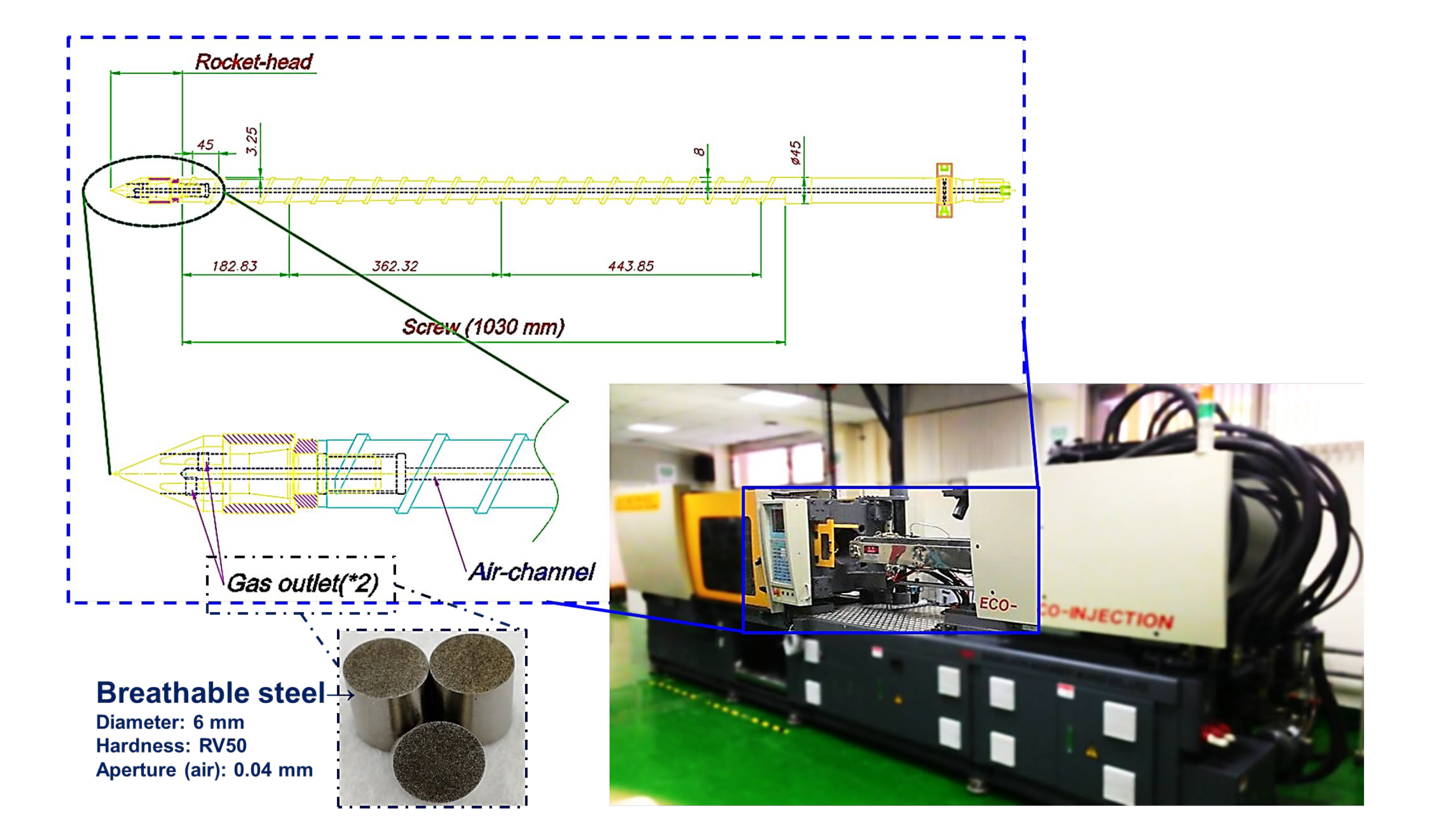
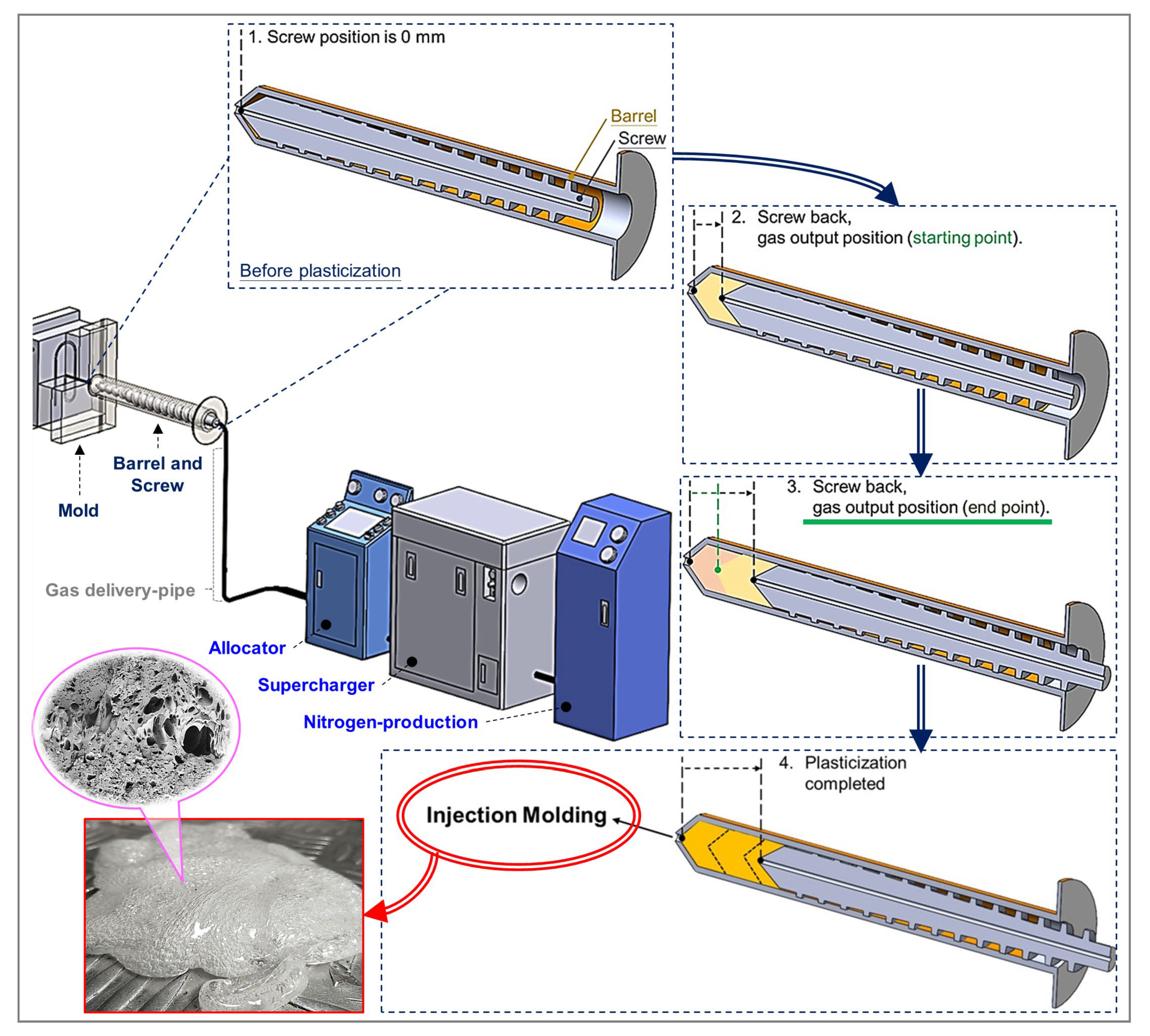
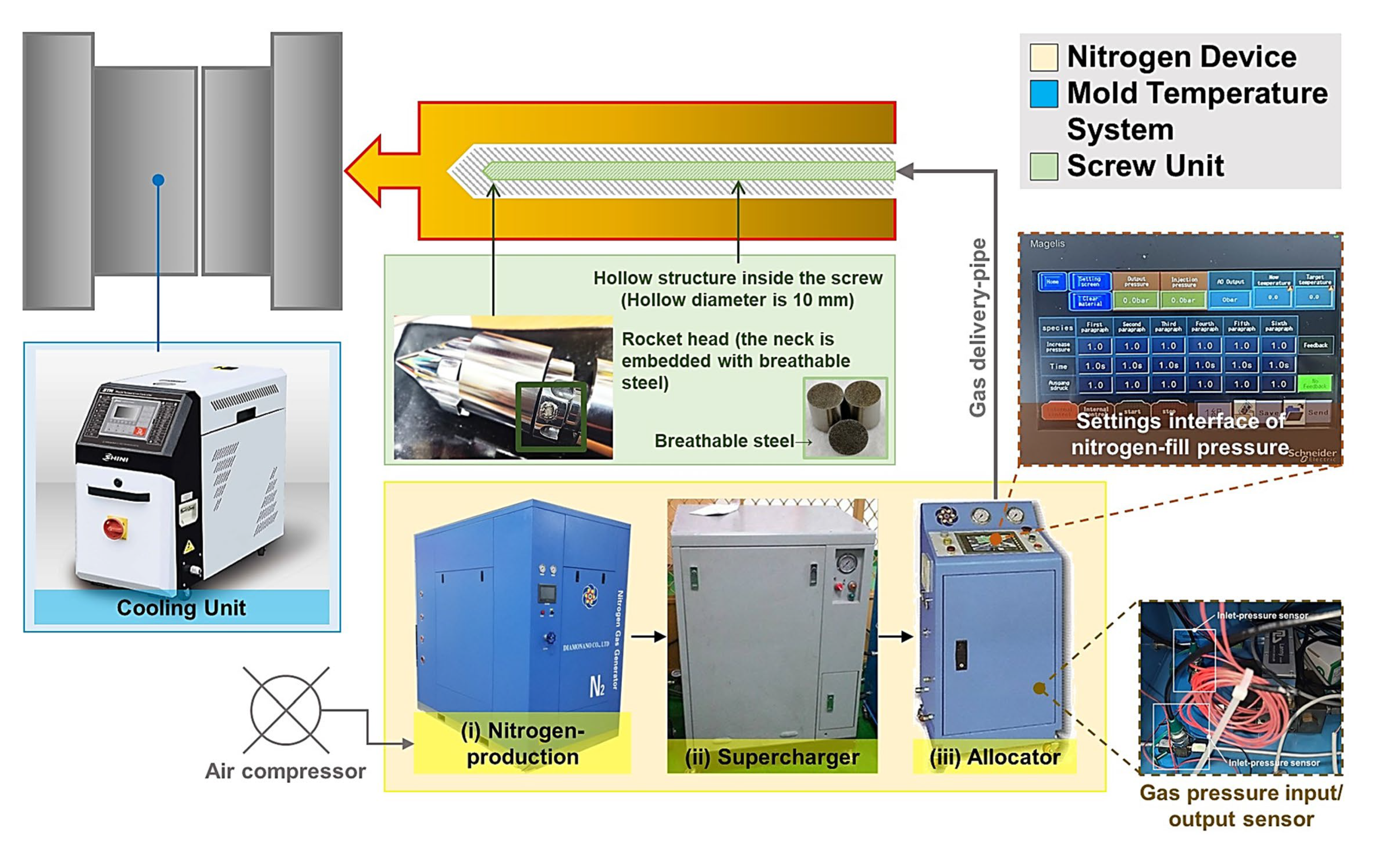

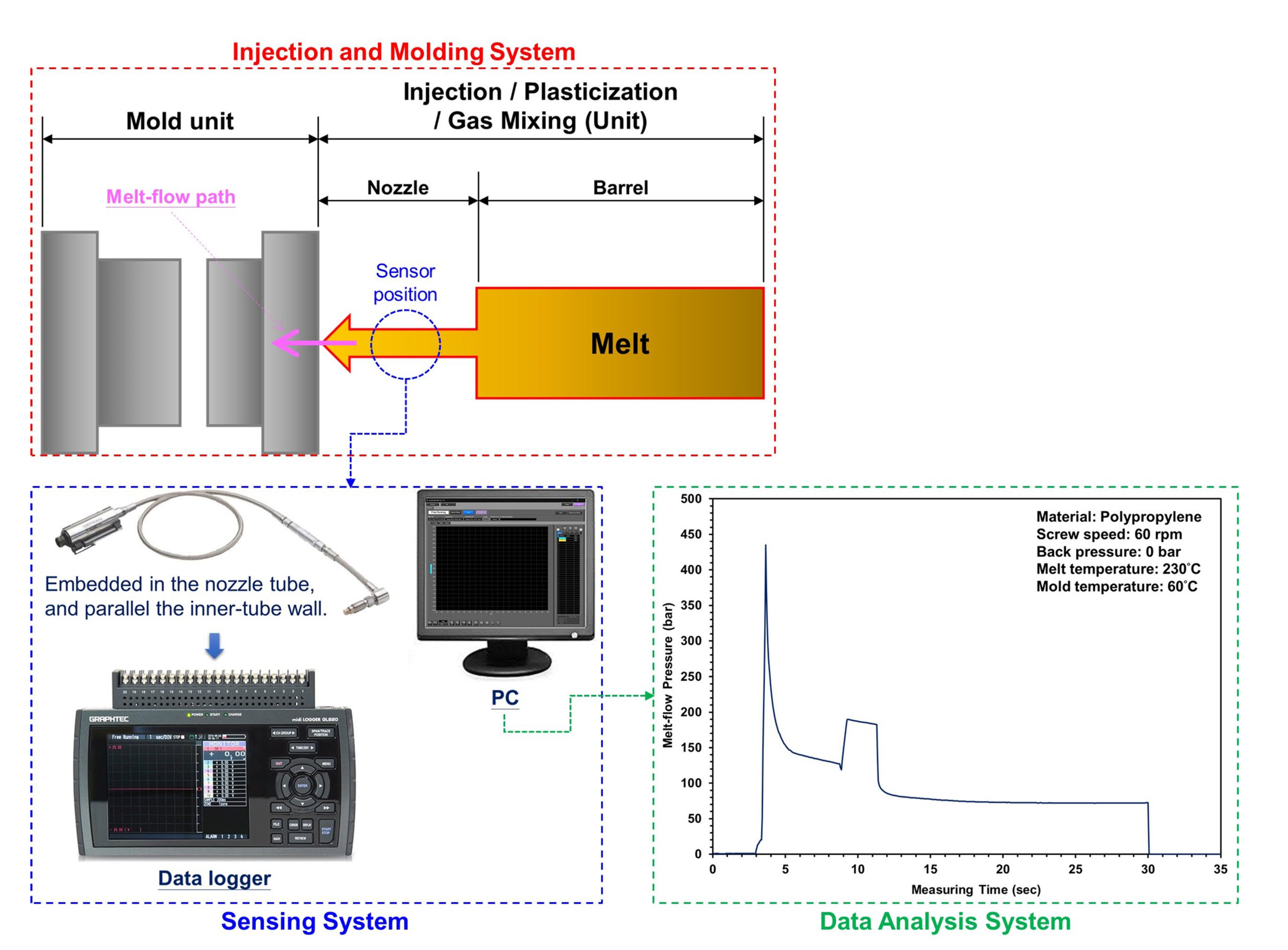
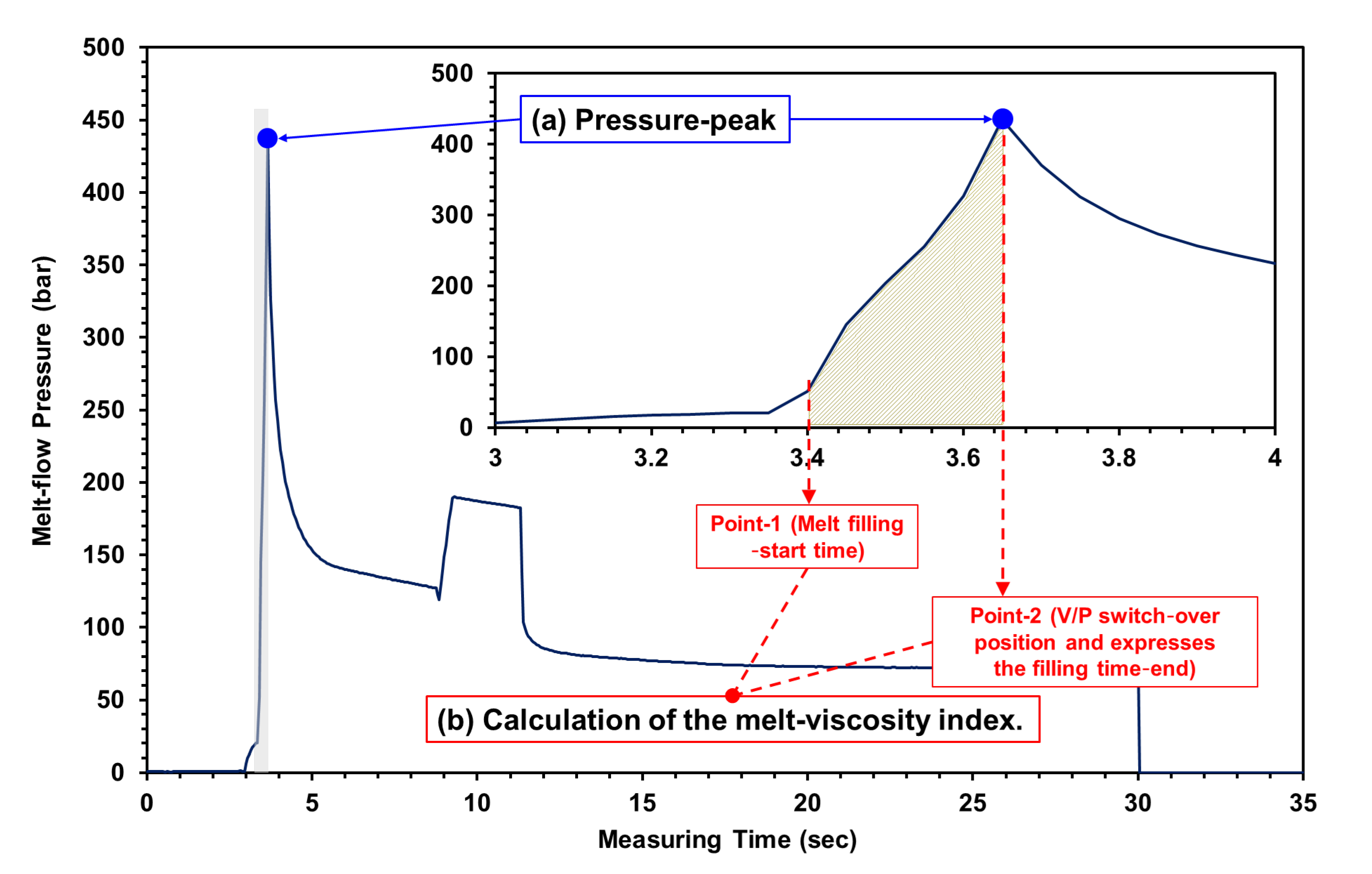
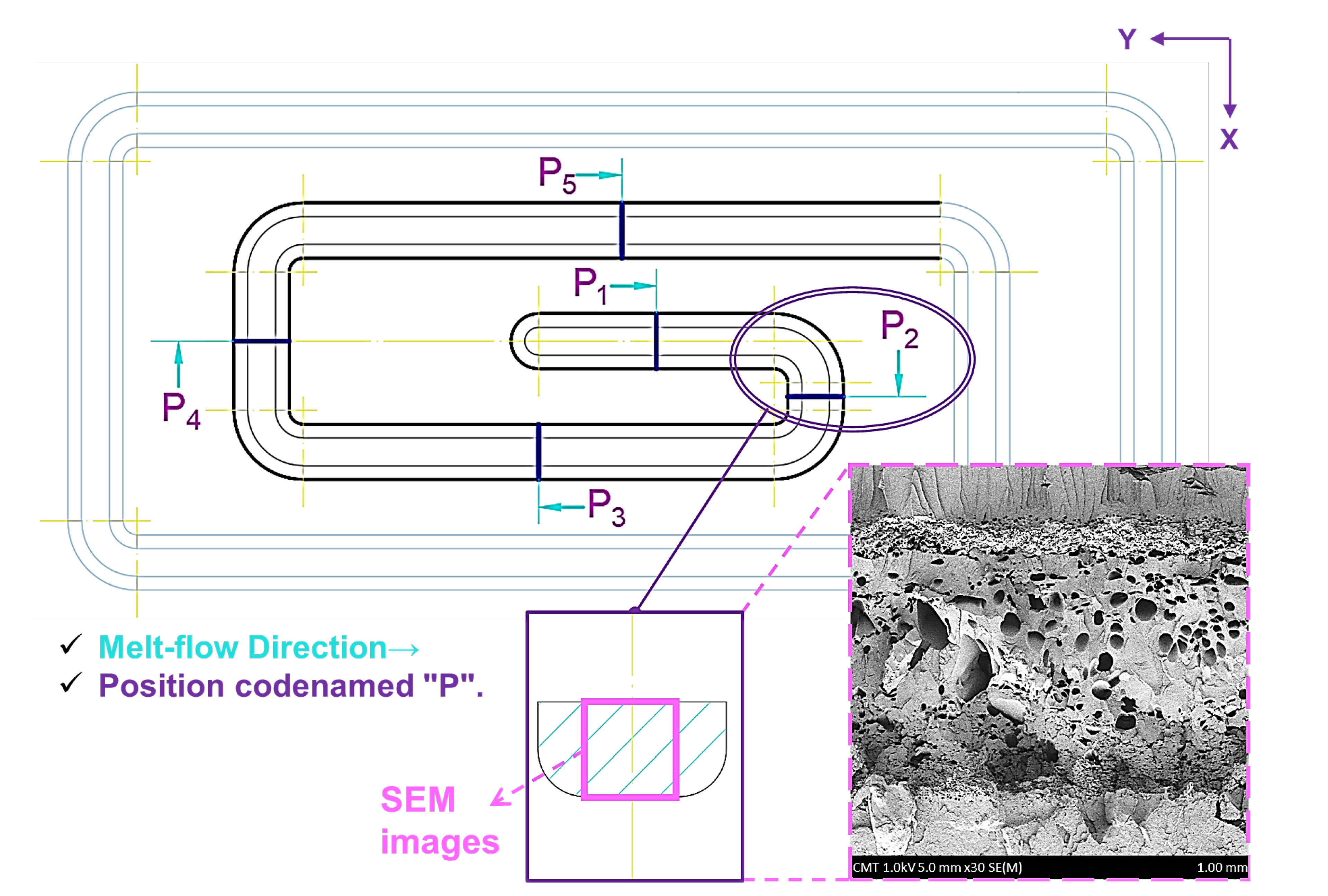


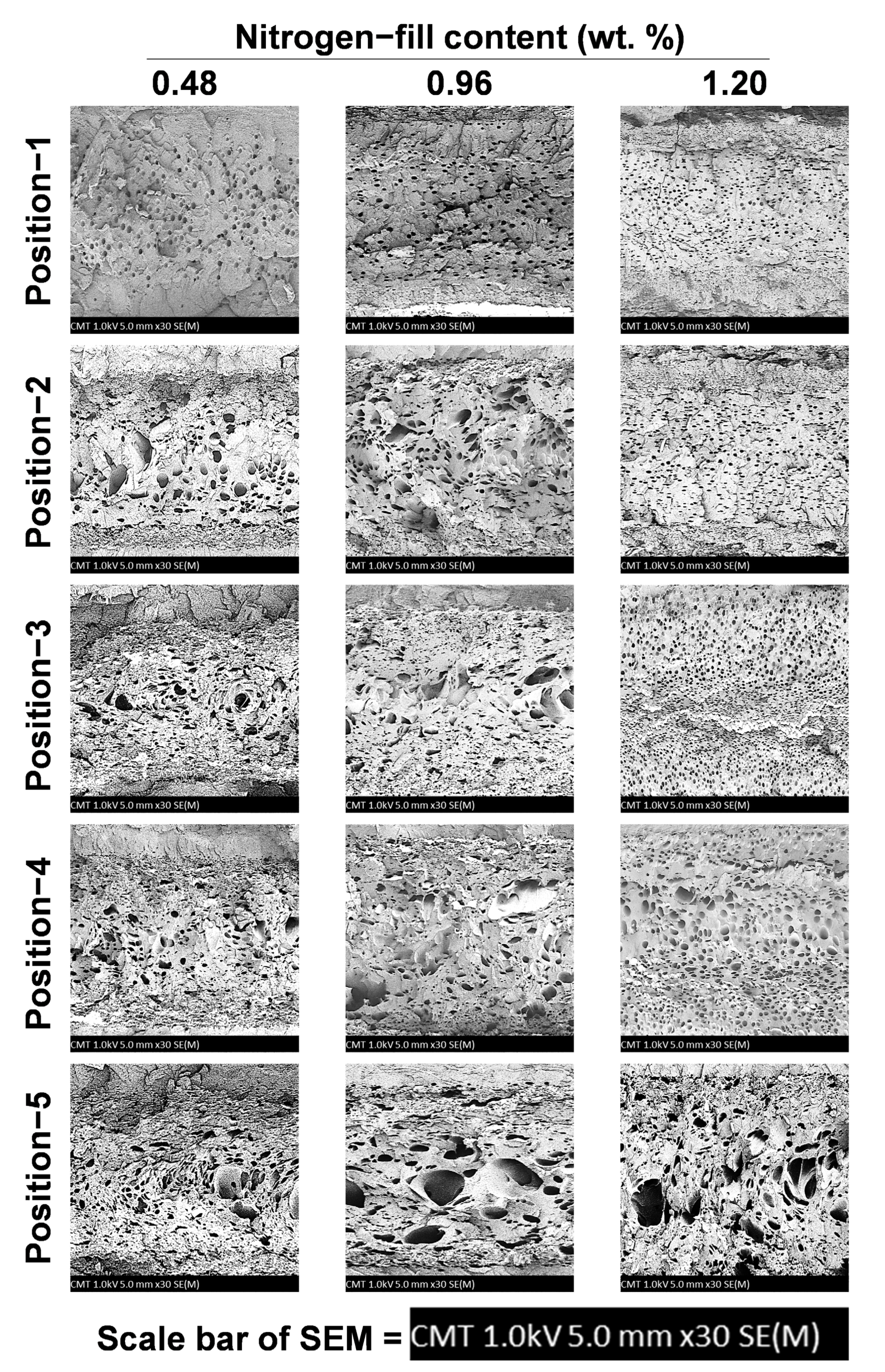
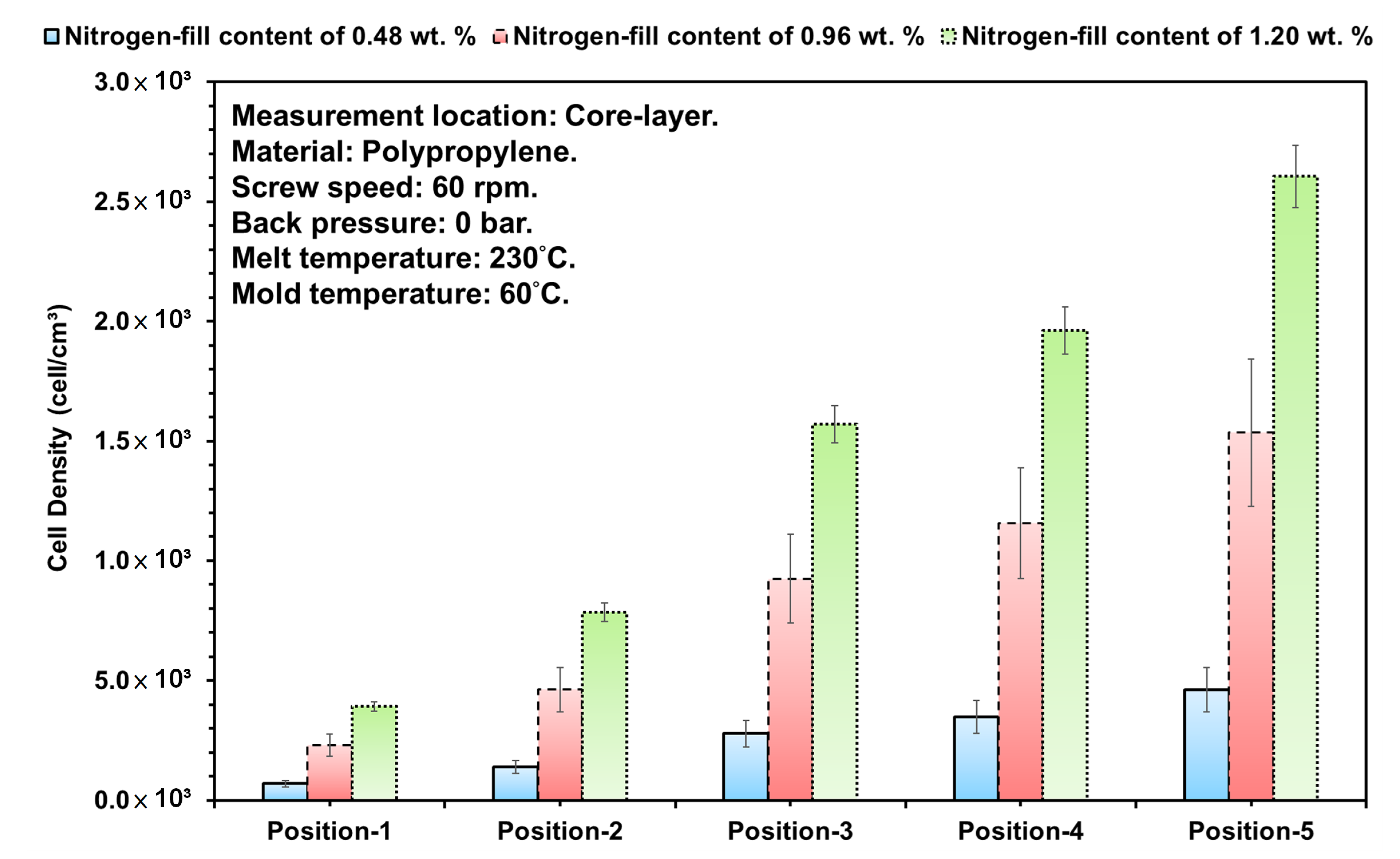
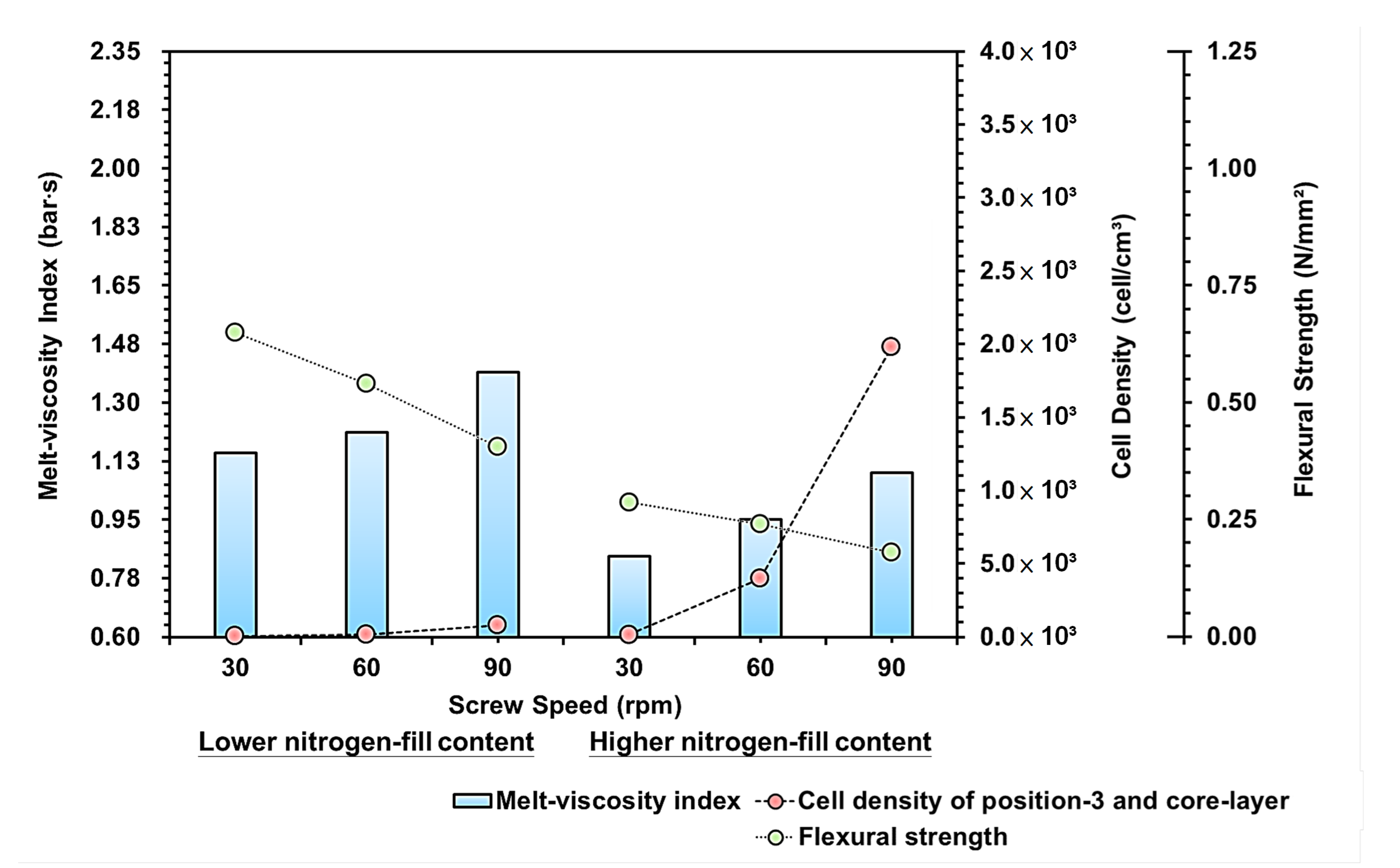
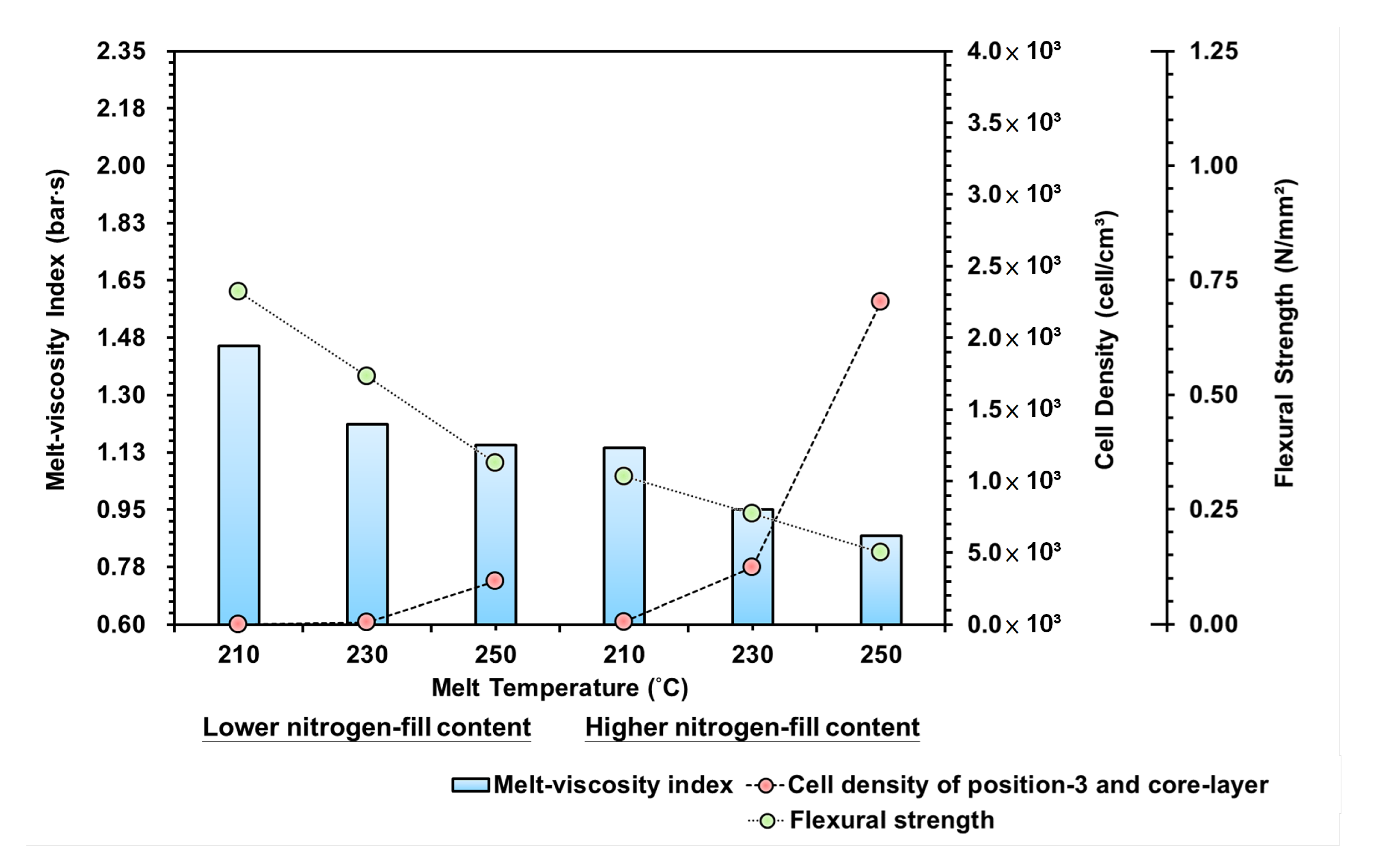
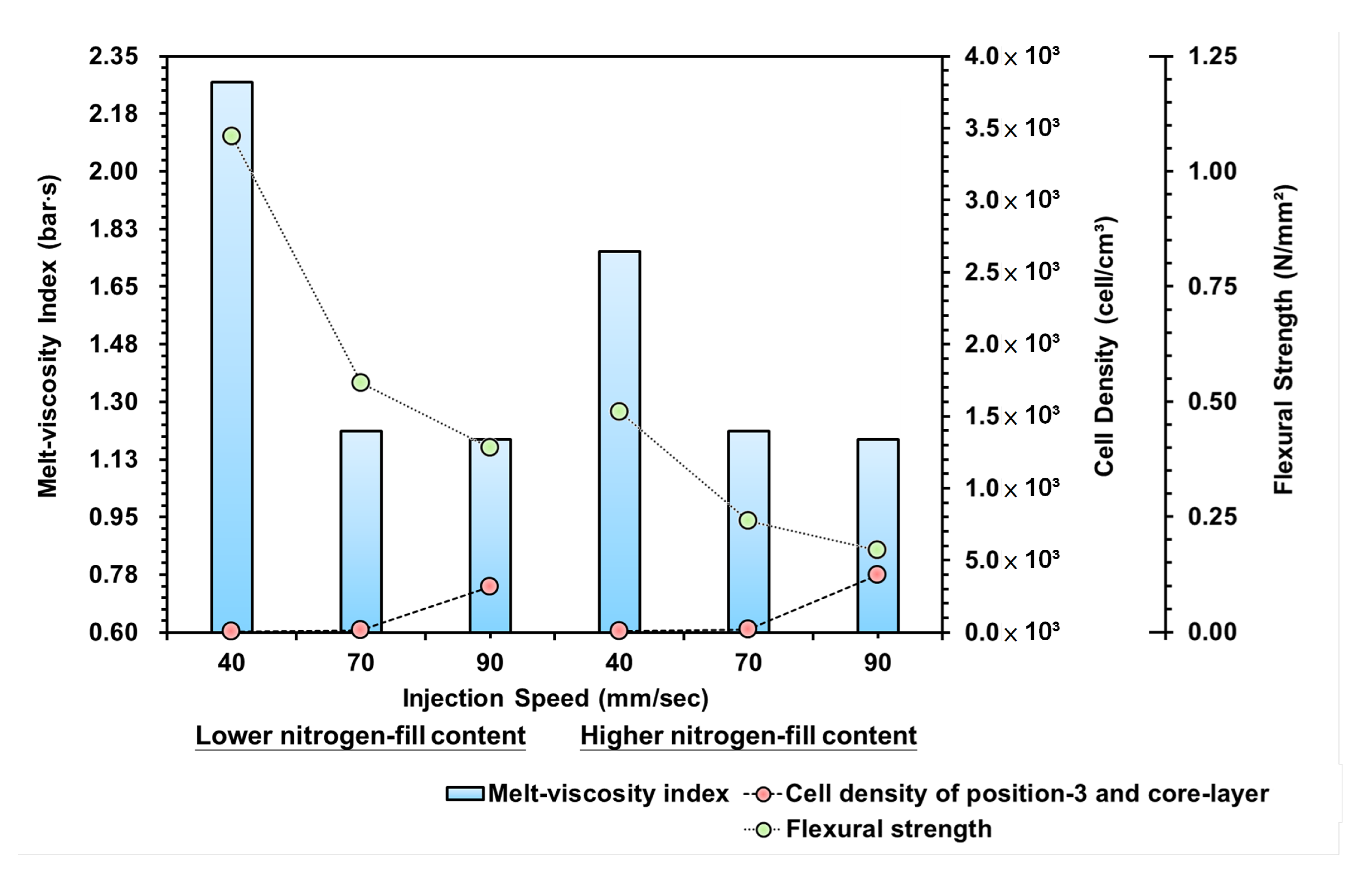
| Constant Factors | Controllable Factors | ||||
|---|---|---|---|---|---|
| Clamping Force (ton) | 50 | Screw Speed (rpm) | 30 | 60 | 90 |
| Mold Temperature (°C) | 60 | Melt Temperature (°C) | 210 | 230 | 250 |
| Cooling Time (s) | 40 | Injection Speed (%) | 40 | 70 | 90 |
| Injection Pressure (bar) | 140 | ||||
| Injection Time (s) | 1.5 | ||||
| V/P Switch-over Position (mm) | 1 | ||||
| Back Pressure (bar) | 0 | ||||
| Gas-fill Time (s) | 10 | ||||
| Exp. | Screw Speed (rpm) | Melt Temperature (°C) | Injection Speed (mm/s) |
|---|---|---|---|
| 1 | 30 | 230 | 70 |
| 2 | 60 | 230 | 70 |
| 3 | 90 | 230 | 70 |
| 4 | 60 | 210 | 70 |
| 5 | 60 | 230 | 70 |
| 6 | 60 | 250 | 70 |
| 7 | 60 | 230 | 40 |
| 8 | 60 | 230 | 70 |
| 9 | 60 | 230 | 90 |
Disclaimer/Publisher’s Note: The statements, opinions and data contained in all publications are solely those of the individual author(s) and contributor(s) and not of MDPI and/or the editor(s). MDPI and/or the editor(s) disclaim responsibility for any injury to people or property resulting from any ideas, methods, instructions or products referred to in the content. |
© 2023 by the authors. Licensee MDPI, Basel, Switzerland. This article is an open access article distributed under the terms and conditions of the Creative Commons Attribution (CC BY) license (https://creativecommons.org/licenses/by/4.0/).
Share and Cite
Huang, P.-W.; Peng, H.-S.; Hwang, S.-J.; Huang, C.-T. Study on the Flow, Foaming Characteristics and Structural Strength of Polypropylene Structural Foam Injection Molding by Innovative Nitrogen and Molten Plastic Mixing Mechanism. Polymers 2023, 15, 2116. https://doi.org/10.3390/polym15092116
Huang P-W, Peng H-S, Hwang S-J, Huang C-T. Study on the Flow, Foaming Characteristics and Structural Strength of Polypropylene Structural Foam Injection Molding by Innovative Nitrogen and Molten Plastic Mixing Mechanism. Polymers. 2023; 15(9):2116. https://doi.org/10.3390/polym15092116
Chicago/Turabian StyleHuang, Po-Wei, Hsin-Shu Peng, Sheng-Jye Hwang, and Chao-Tsai Huang. 2023. "Study on the Flow, Foaming Characteristics and Structural Strength of Polypropylene Structural Foam Injection Molding by Innovative Nitrogen and Molten Plastic Mixing Mechanism" Polymers 15, no. 9: 2116. https://doi.org/10.3390/polym15092116









